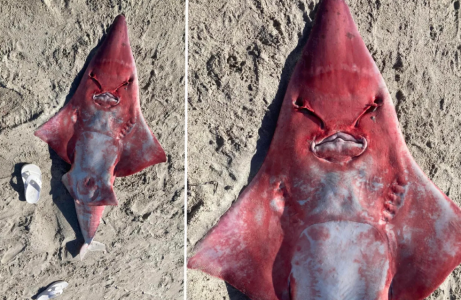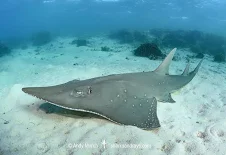See the bizarre 'alien' creature discovered on an Aussie beach that has everyone talking!
By
- Replies 7
Australia is renowned for its unique and diverse wildlife on land and in the sea. But even by Aussie standards, discovering a rarely-seen marine creature on a popular beach has left locals and online onlookers in awe.
On a sunny Saturday, a beachgoer's stroll along Coogee Beach in Perth took an unexpected turn when they stumbled upon an unusual sight. On the sand lay a deceased animal that seemed to be part fish, part enigma. With the body and fins reminiscent of a shark, coupled with a flattened head and a ventral mouth like that of a ray, the creature appeared to be something out of a science fiction novel.
Photos of the bizarre find quickly made their way to social media, sparking a flurry of comments and speculation. Some likened the creature to an alien visitor, while others pondered the mystery of how it ended up on the beach. The images captured the attention of marine biologists and curious citizens alike, all eager to understand more about this strange specimen.
Leo Guida from the Australian Marine Conservation Society shed light on the creature's identity, confirming it as a bottlenose wedgefish, also known as a white-spotted guitarfish. Despite its otherworldly appearance, this species is no stranger to Australian waters, where it finds a safe haven. Guida explained that while the bottlenose wedgefish is critically endangered globally, Australia serves as a 'lifeboat' for the species, thanks to more sustainable fishing practices and conservation measures.
Commercial trawlers in Australia are equipped with 'turtle excluder devices', which include an escape hatch allowing large wedgefish to avoid capture. This innovation has significantly reduced the incidental killing of these creatures in Australian waters, contributing to their relative abundance compared to other regions.
The red bruising visible on the fish, as noted in the photos, is a result of internal blood pooling, a common occurrence after death when gravity takes its toll. This detail, while initially alarming to some, is a natural part of the decomposition process.
Bottlenose wedgefish belong to the family Rhinidae and are part of a larger group of cartilaginous fish known as elasmobranchs, which encompasses both sharks and rays. Despite their shark-like features, they are not hybrids but a distinct species within this fascinating group. The critical endangerment of the wedgefish is primarily due to overfishing and habitat destruction, with their fins being particularly sought after for the shark fin trade.
The degradation of coastal environments, including pollution and the destruction of vital habitats such as mangroves and seagrass beds, has further reduced the areas where wedgefish can thrive. Their biological characteristics, including slow growth rates, late sexual maturity, and low reproductive output, make it challenging for their populations to bounce back once they've declined.
This rare encounter on Coogee Beach serves as a stark reminder of the fragility of marine ecosystems and the importance of conservation efforts. It also highlights the wonder of Australia's marine biodiversity, where even the most 'alien' of creatures can be part of our natural heritage.
For those who cherish Australia's weird and wonderful environment, this discovery is a testament to the ongoing need to protect our precious aquatic life. It's a call to action for all Australians to support sustainable practices and to marvel at the incredible species that call our waters home.
 Have you ever come across an unusual marine creature on your beach visits? Share your experiences and thoughts on the importance of marine conservation in the comments below. Let's celebrate and safeguard the extraordinary biodiversity of our Aussie shores!
Have you ever come across an unusual marine creature on your beach visits? Share your experiences and thoughts on the importance of marine conservation in the comments below. Let's celebrate and safeguard the extraordinary biodiversity of our Aussie shores!
On a sunny Saturday, a beachgoer's stroll along Coogee Beach in Perth took an unexpected turn when they stumbled upon an unusual sight. On the sand lay a deceased animal that seemed to be part fish, part enigma. With the body and fins reminiscent of a shark, coupled with a flattened head and a ventral mouth like that of a ray, the creature appeared to be something out of a science fiction novel.
Photos of the bizarre find quickly made their way to social media, sparking a flurry of comments and speculation. Some likened the creature to an alien visitor, while others pondered the mystery of how it ended up on the beach. The images captured the attention of marine biologists and curious citizens alike, all eager to understand more about this strange specimen.
Leo Guida from the Australian Marine Conservation Society shed light on the creature's identity, confirming it as a bottlenose wedgefish, also known as a white-spotted guitarfish. Despite its otherworldly appearance, this species is no stranger to Australian waters, where it finds a safe haven. Guida explained that while the bottlenose wedgefish is critically endangered globally, Australia serves as a 'lifeboat' for the species, thanks to more sustainable fishing practices and conservation measures.
Commercial trawlers in Australia are equipped with 'turtle excluder devices', which include an escape hatch allowing large wedgefish to avoid capture. This innovation has significantly reduced the incidental killing of these creatures in Australian waters, contributing to their relative abundance compared to other regions.
The red bruising visible on the fish, as noted in the photos, is a result of internal blood pooling, a common occurrence after death when gravity takes its toll. This detail, while initially alarming to some, is a natural part of the decomposition process.
Bottlenose wedgefish belong to the family Rhinidae and are part of a larger group of cartilaginous fish known as elasmobranchs, which encompasses both sharks and rays. Despite their shark-like features, they are not hybrids but a distinct species within this fascinating group. The critical endangerment of the wedgefish is primarily due to overfishing and habitat destruction, with their fins being particularly sought after for the shark fin trade.
The degradation of coastal environments, including pollution and the destruction of vital habitats such as mangroves and seagrass beds, has further reduced the areas where wedgefish can thrive. Their biological characteristics, including slow growth rates, late sexual maturity, and low reproductive output, make it challenging for their populations to bounce back once they've declined.
This rare encounter on Coogee Beach serves as a stark reminder of the fragility of marine ecosystems and the importance of conservation efforts. It also highlights the wonder of Australia's marine biodiversity, where even the most 'alien' of creatures can be part of our natural heritage.
For those who cherish Australia's weird and wonderful environment, this discovery is a testament to the ongoing need to protect our precious aquatic life. It's a call to action for all Australians to support sustainable practices and to marvel at the incredible species that call our waters home.
Key Takeaways
- A rarely-seen 'alien' creature, which is a bottlenose wedgefish, was found washed up on Coogee Beach in Perth.
- The creature, critically endangered globally, is not threatened in Australian waters thanks to conservation efforts.
- The bottlenose wedgefish are part of the family Rhinidae, also known as wedgefish, and belong to a group of cartilaginous fish that includes sharks and rays.
- These fish are critically endangered due to factors like overfishing, habitat destruction, and the value of their fins in the shark fin trade, with slow reproduction rates making population recovery difficult.










